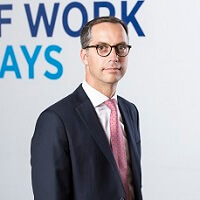Workforce planning for now and the next normal
BLOG

WORKFORCE PLANNING FOR NOW AND THE NEXT NORMAL

Politicians, economists, the media, everyone seems to want to quantify the impact of COVID-19 — but no one knows the outcome. Most are just trying to deal with the now. For business leaders decision-making feels like a roll of the dice. Workforce planning feels an impossible dream. But, could it be part of the answer to how we emerge healthier and more balanced into the future we all need right now?
Building an effective workforce, beyond remote working tips
Plenty has been written about the importance of engaging with and maintaining a productive workforce during the crisis. But as some countries start to relax their lock down measures we need to move beyond tips on, and effective management of remote working.
To handle the tough decision making that comes with the economic chaos we’re witnessing, leaders have been working to ensure their organisation is agile enough to meet the demands of today, with the ability to pivot rapidly against a clear purpose to make the right decisions for tomorrow.
Getting the right people, in the right place, at the right time and cost will be central to success and effective workforce planning, will be critical to this. Without it how can you be sure you’re making the right, responsive and responsible resourcing decisions for your business and your employees?
Moving workforce planning from the too hard pile
Much like Total Talent Management programmes, there seems to be a gap between intent and reality. Workforce planning and strategy seems to feature on every board room agenda. Yet in most organisations isn’t effectively executed against at a strategic level. It seems to become very responsive or fall into the too hard basket. But it doesn’t have to.
One of the biggest mistakes we see is people confusing workforce planning with a plan. We’ve all heard the old cliché, fail to plan, plan to fail. But, how often have things ever gone to plan?
Workforce planning is a process. Not an annual to-do. At its heart workforce planning is aligning the organisational needs and people strategy.
It doesn’t need to be complex. And can be adjusted to suit the size and maturity of your workforce programme.
Getting started in workforce planning during a crisis
A simple way to get started is to have a documented check-in with your business unit leaders every other week. Most businesses have already done this on the downside as a response to COVID-19, its maintaining this discipline and identifying the workforce priorities, their anticipated resourcing needs and critical dependencies on an ongoing basis.
The answers don’t need to be perfect, or questions cumbersome. The process can be as simple as a live document update every other week.
The point is to get a concrete picture of what you’re dealing with, so you can make the right talent supply chain decisions for the here and now. We all know things will have changed, but if you haven’t documented these and ask the pertinent questions how can you support them to access the skills they need?
Workforce planning for different scenarios
Once you have the above in place to deal with the right now you’ll need to develop a workforce planning group, to identify a range of realistic variables and resourcing options, accounting for fluctuations in demand, productivity, skills availability and an ever-evolving world of work.
Developing scenarios and stress-testing how your workforce programme will stand up to these variances allows you to identify triggers for action. So, you’re no longer reacting, but have clear well-thought out options to handle a range of possible outcomes quickly when the time comes.
You’ll then need to be sure you’re tracking the signals that different scenarios are becoming more likely, so you are primed to act. As we all know not all talent is immediately available and will need pipelining and planning for.
Planning with purpose
Finally, you’ll need to establish what the next normal means for your business after the immediate crisis passes. What will have changed forever, what new ways of working do you want to keep and what does this mean for your workforce and then communicate it.
Workforce strategy should reflect business strategy and your organisation’s purpose. Those who work with and for you want to know what an organisation stands for. And this stands true during this crisis more than ever. As whilst your workers may be physically separated, they are united by your purpose and values. This is critical to maintaining and potentially reforming your organisational culture which forms the foundation for future success.
By understanding the broad direction in which you are travelling, you can guide not only your own decisions. But, you empower your leaders to make more informed, future-focused, not knee-jerk panic led, people decisions too.
Act for now and next
Whilst no-one can accurately predict with any certainty what will come next. It is clear responsive and responsible workforce planning will be required to navigate the now and the next normal. Because the skills you need today will not be the same as those you need tomorrow.
This uncertainty will require you to cycle through your workforce planning process more often than ever. Scenarios will need to be refined and refreshed. Don’t worry about perfection. Each iteration will improve over time.
But start today, so when the next stage of the COVID-19 crisis hits you are the first to know and fastest to act, because you’ll have done the thinking, identified the people and created the plans to do so.
Visit our new ways of working resources hub for guides on video interviewing, onboarding remotely and which tools to use and when.
Missed our webinar?
Catch up on our webinar with featured guest speaker from industry analysts, Everest Group to help adapt your workforce strategy for now and the next normal.
Download our latest whitepaper
We provide an overview of how progressive organisations are tackling today’s challenges, outline a new approach to workforce planning and provide a supporting template to support you in applying it.
Get your copyAUTHOR

Matthew Dickason
Global Managing Director, Hays Talent Solutions
Matthew is the Global Managing Director for Hays Talent Solutions, having joined Hays in 2005. Previous roles held at Hays include Business Director in the UK and Chief Operating Officer for Asia Pacific. He is now responsible for leading the global business of Hays Talent Solutions and investing to ensure clients retain a competitive advantage in talent acquisition from the delivery of Hays MSP, RPO, technology and modular service solutions.
Prior to joining Hays, Matthew worked within Engineering, Research, Operations and Commercial areas at Johnson Matthey and Corning Inc. He has formal qualifications in Organisational Psychology and Industrial Engineering.
